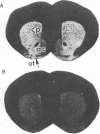Abstract
N-Methyl-4-phenyl-1,2,3,6-tetrahydropyridine (MPTP) produces neuropathological and clinical abnormalities in humans, monkeys, and mice that closely resemble idiopathic parkinsonism. N-Methyl-4-phenylpyridine (MPP+), a metabolite of MPTP formed by monoamine oxidase B, is accumulated into striatal and cerebral cortical synaptosomes by the dopamine and norepinephrine uptake systems, respectively, whereas MPTP itself is not accumulated. The potencies of drugs in inhibiting [3H]MPP+ or [3H]dopamine uptake into striatal synaptosomes are very similar, as are potencies in inhibiting [3H]MPP+ or [3H]norepinephrine uptake into cortical synaptosomes. The Km values for [3H]MPP+ uptake are 170 and 65 nM and the Vmax values are 2 and 0.1 nmol/g of tissue per min in rat striatum and cortex, respectively, similar to values for [3H]dopamine uptake, Autoradiography of accumulated [3H]MPP+ in slices of rat brain shows high densities in the caudate-putamen and nucleus accumbens. Furthermore, blockade of dopamine uptake by mazindol prevents MPTP-induced damage to nigrostriatal dopamine neurons, indicating that MPP+ concentration into dopamine neurons explains their selective destruction by MPTP.
Full text
PDF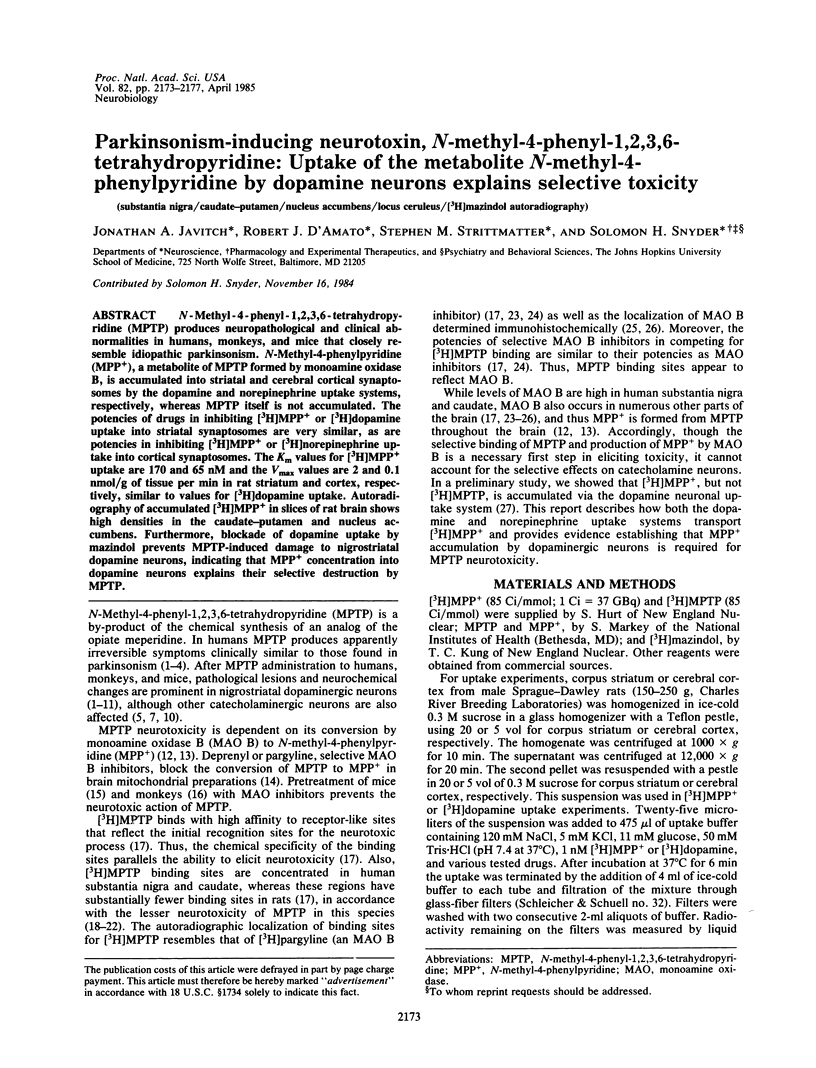
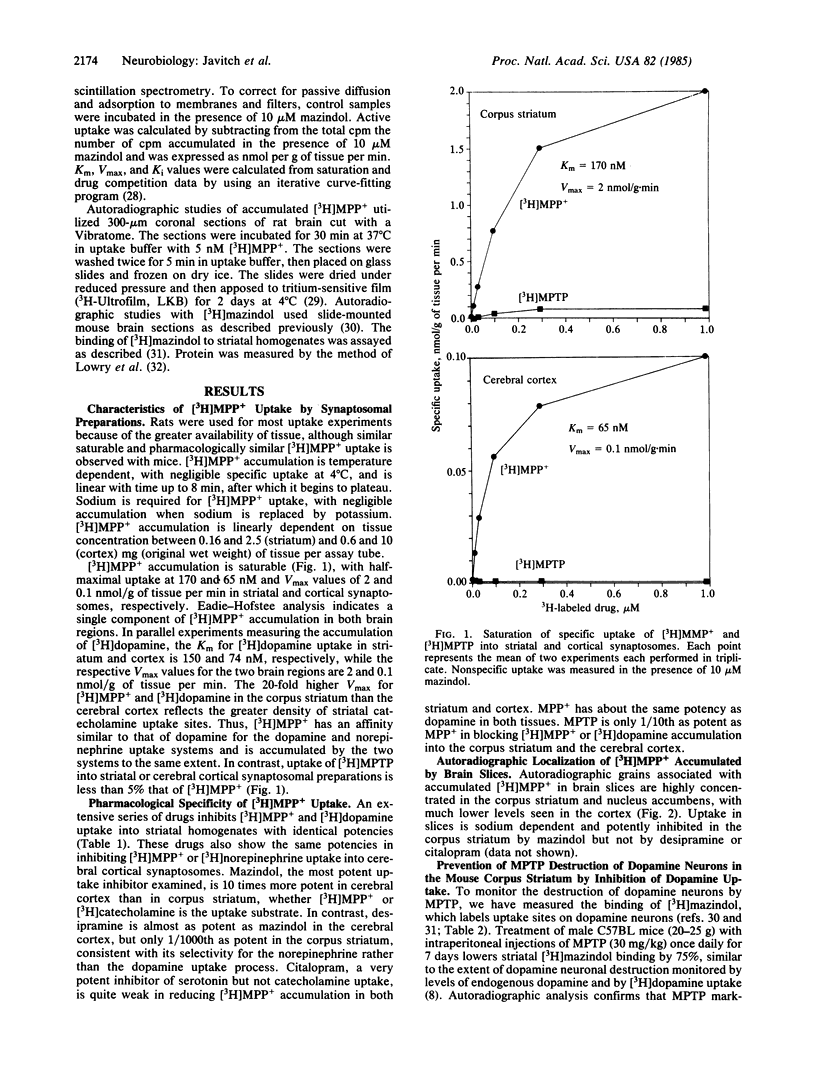
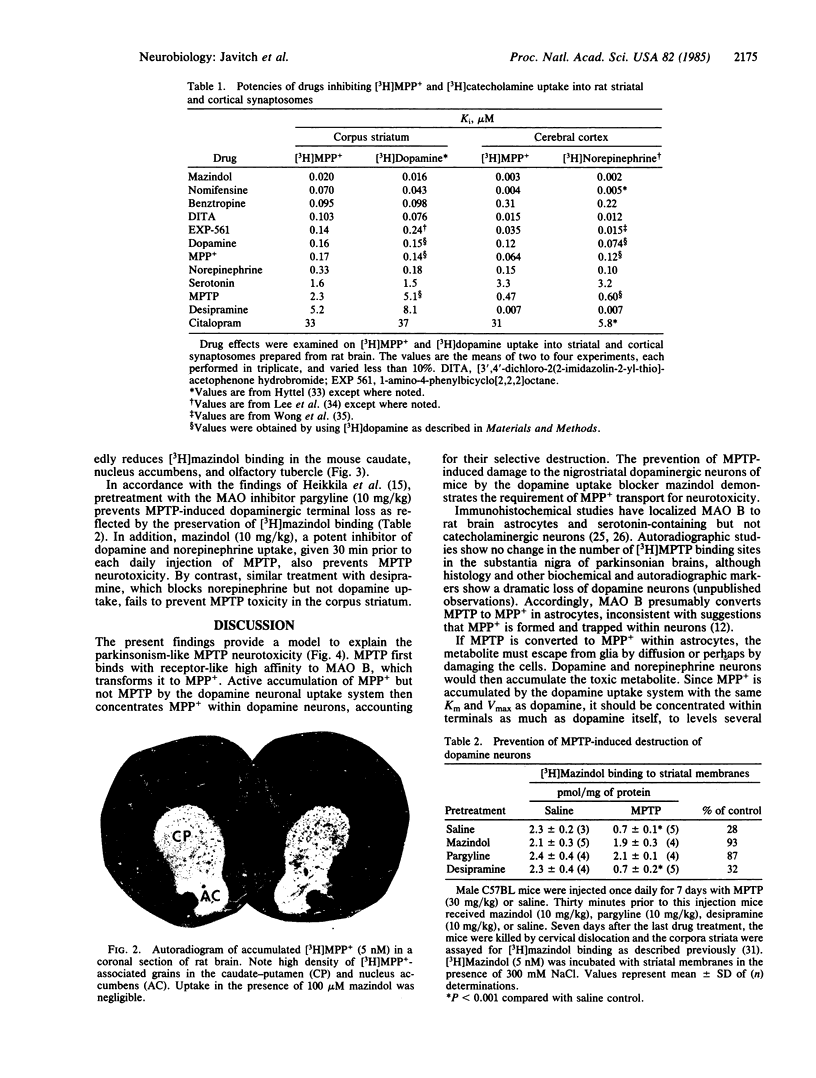
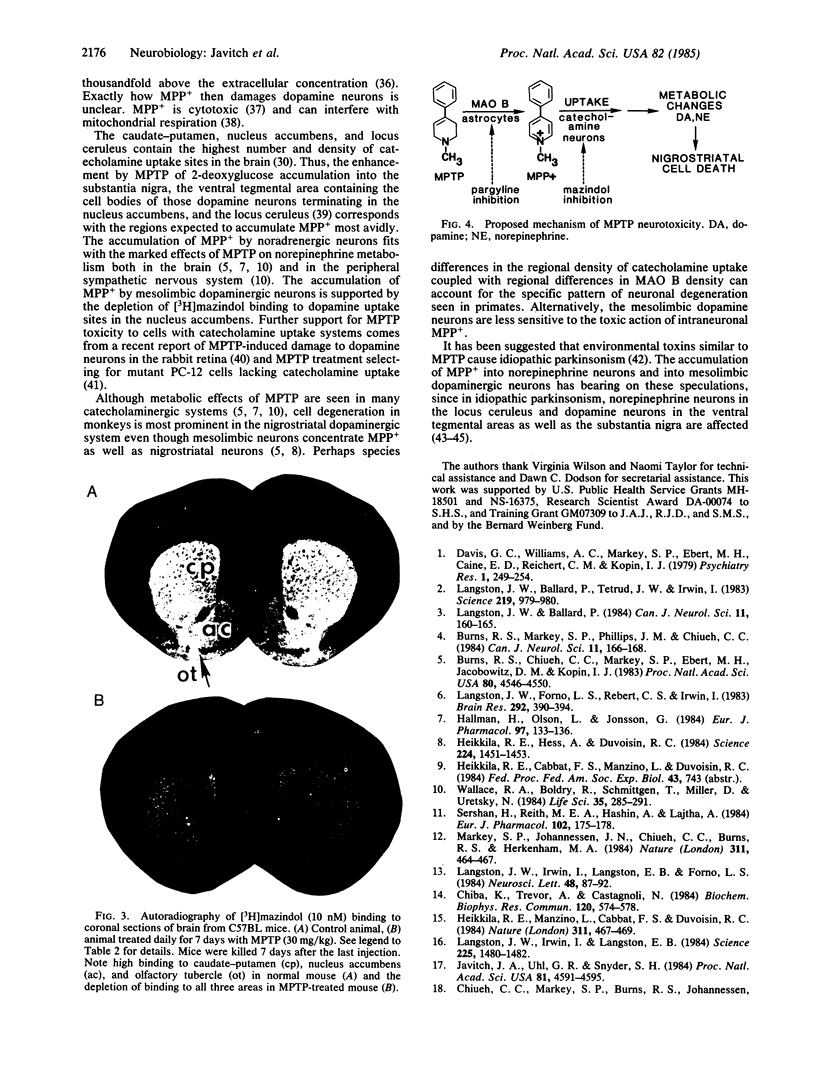

Images in this article
Selected References
These references are in PubMed. This may not be the complete list of references from this article.
- Boyce S., Kelly E., Reavill C., Jenner P., Marsden C. D. Repeated administration of N-methyl-4-phenyl 1,2,5,6-tetrahydropyridine to rats is not toxic to striatal dopamine neurones. Biochem Pharmacol. 1984 Jun 1;33(11):1747–1752. doi: 10.1016/0006-2952(84)90344-7. [DOI] [PubMed] [Google Scholar]
- Burns R. S., Chiueh C. C., Markey S. P., Ebert M. H., Jacobowitz D. M., Kopin I. J. A primate model of parkinsonism: selective destruction of dopaminergic neurons in the pars compacta of the substantia nigra by N-methyl-4-phenyl-1,2,3,6-tetrahydropyridine. Proc Natl Acad Sci U S A. 1983 Jul;80(14):4546–4550. doi: 10.1073/pnas.80.14.4546. [DOI] [PMC free article] [PubMed] [Google Scholar]
- Burns R. S., Markey S. P., Phillips J. M., Chiueh C. C. The neurotoxicity of 1-methyl-4-phenyl-1,2,3,6-tetrahydropyridine in the monkey and man. Can J Neurol Sci. 1984 Feb;11(1 Suppl):166–168. doi: 10.1017/s0317167100046345. [DOI] [PubMed] [Google Scholar]
- Chiba K., Trevor A., Castagnoli N., Jr Metabolism of the neurotoxic tertiary amine, MPTP, by brain monoamine oxidase. Biochem Biophys Res Commun. 1984 Apr 30;120(2):574–578. doi: 10.1016/0006-291x(84)91293-2. [DOI] [PubMed] [Google Scholar]
- Chiueh C. C., Markey S. P., Burns R. S., Johannessen J. N., Pert A., Kopin I. J. Neurochemical and behavioral effects of systemic and intranigral administration of N-methyl-4-phenyl-1,2,3,6-tetrahydropyridine in the rat. Eur J Pharmacol. 1984 Apr 20;100(2):189–194. doi: 10.1016/0014-2999(84)90221-8. [DOI] [PubMed] [Google Scholar]
- Davis G. C., Williams A. C., Markey S. P., Ebert M. H., Caine E. D., Reichert C. M., Kopin I. J. Chronic Parkinsonism secondary to intravenous injection of meperidine analogues. Psychiatry Res. 1979 Dec;1(3):249–254. doi: 10.1016/0165-1781(79)90006-4. [DOI] [PubMed] [Google Scholar]
- GREENFIELD J. G., BOSANQUET F. D. The brain-stem lesions in Parkinsonism. J Neurol Neurosurg Psychiatry. 1953 Nov;16(4):213–226. doi: 10.1136/jnnp.16.4.213. [DOI] [PMC free article] [PubMed] [Google Scholar]
- Hallman H., Olson L., Jonsson G. Neurotoxicity of the meperidine analogue N-methyl-4-phenyl-1,2,3,6-tetrahydropyridine on brain catecholamine neurons in the mouse. Eur J Pharmacol. 1984 Jan 13;97(1-2):133–136. doi: 10.1016/0014-2999(84)90521-1. [DOI] [PubMed] [Google Scholar]
- Hamberger B., Masuoka D. Localization of catecholamine uptake in rat brain slices. Acta Pharmacol Toxicol (Copenh) 1965;22(4):363–368. doi: 10.1111/j.1600-0773.1965.tb01831.x. [DOI] [PubMed] [Google Scholar]
- Heikkila R. E., Hess A., Duvoisin R. C. Dopaminergic neurotoxicity of 1-methyl-4-phenyl-1,2,5,6-tetrahydropyridine in mice. Science. 1984 Jun 29;224(4656):1451–1453. doi: 10.1126/science.6610213. [DOI] [PubMed] [Google Scholar]
- Heikkila R. E., Manzino L., Cabbat F. S., Duvoisin R. C. Protection against the dopaminergic neurotoxicity of 1-methyl-4-phenyl-1,2,5,6-tetrahydropyridine by monoamine oxidase inhibitors. Nature. 1984 Oct 4;311(5985):467–469. doi: 10.1038/311467a0. [DOI] [PubMed] [Google Scholar]
- Hyttel J. Citalopram--pharmacological profile of a specific serotonin uptake inhibitor with antidepressant activity. Prog Neuropsychopharmacol Biol Psychiatry. 1982;6(3):277–295. doi: 10.1016/s0278-5846(82)80179-6. [DOI] [PubMed] [Google Scholar]
- Javitch J. A., Blaustein R. O., Snyder S. H. [3H]mazindol binding associated with neuronal dopamine and norepinephrine uptake sites. Mol Pharmacol. 1984 Jul;26(1):35–44. [PubMed] [Google Scholar]
- Javitch J. A., Uhl G. R., Snyder S. H. Parkinsonism-inducing neurotoxin, N-methyl-4-phenyl-1,2,3,6 -tetrahydropyridine: characterization and localization of receptor binding sites in rat and human brain. Proc Natl Acad Sci U S A. 1984 Jul;81(14):4591–4595. doi: 10.1073/pnas.81.14.4591. [DOI] [PMC free article] [PubMed] [Google Scholar]
- LOWRY O. H., ROSEBROUGH N. J., FARR A. L., RANDALL R. J. Protein measurement with the Folin phenol reagent. J Biol Chem. 1951 Nov;193(1):265–275. [PubMed] [Google Scholar]
- Langston J. W., Ballard P. Parkinsonism induced by 1-methyl-4-phenyl-1,2,3,6-tetrahydropyridine (MPTP): implications for treatment and the pathogenesis of Parkinson's disease. Can J Neurol Sci. 1984 Feb;11(1 Suppl):160–165. doi: 10.1017/s0317167100046333. [DOI] [PubMed] [Google Scholar]
- Langston J. W., Ballard P., Tetrud J. W., Irwin I. Chronic Parkinsonism in humans due to a product of meperidine-analog synthesis. Science. 1983 Feb 25;219(4587):979–980. doi: 10.1126/science.6823561. [DOI] [PubMed] [Google Scholar]
- Langston J. W., Forno L. S., Rebert C. S., Irwin I. Selective nigral toxicity after systemic administration of 1-methyl-4-phenyl-1,2,5,6-tetrahydropyrine (MPTP) in the squirrel monkey. Brain Res. 1984 Feb 6;292(2):390–394. doi: 10.1016/0006-8993(84)90777-7. [DOI] [PubMed] [Google Scholar]
- Langston J. W., Irwin I., Langston E. B., Forno L. S. 1-Methyl-4-phenylpyridinium ion (MPP+): identification of a metabolite of MPTP, a toxin selective to the substantia nigra. Neurosci Lett. 1984 Jul 13;48(1):87–92. doi: 10.1016/0304-3940(84)90293-3. [DOI] [PubMed] [Google Scholar]
- Langston J. W., Irwin I., Langston E. B., Forno L. S. Pargyline prevents MPTP-induced parkinsonism in primates. Science. 1984 Sep 28;225(4669):1480–1482. doi: 10.1126/science.6332378. [DOI] [PubMed] [Google Scholar]
- Lee C. M., Javitch J. A., Snyder S. H. Characterization of [3H]desipramine binding associated with neuronal norepinephrine uptake sites in rat brain membranes. J Neurosci. 1982 Oct;2(10):1515–1525. doi: 10.1523/JNEUROSCI.02-10-01515.1982. [DOI] [PMC free article] [PubMed] [Google Scholar]
- Levitt P., Pintar J. E., Breakefield X. O. Immunocytochemical demonstration of monoamine oxidase B in brain astrocytes and serotonergic neurons. Proc Natl Acad Sci U S A. 1982 Oct;79(20):6385–6389. doi: 10.1073/pnas.79.20.6385. [DOI] [PMC free article] [PubMed] [Google Scholar]
- Lewin R. Brain enzyme is the target of drug toxin. Science. 1984 Sep 28;225(4669):1460–1462. doi: 10.1126/science.6433484. [DOI] [PubMed] [Google Scholar]
- Markey S. P., Johannessen J. N., Chiueh C. C., Burns R. S., Herkenham M. A. Intraneuronal generation of a pyridinium metabolite may cause drug-induced parkinsonism. Nature. 1984 Oct 4;311(5985):464–467. doi: 10.1038/311464a0. [DOI] [PubMed] [Google Scholar]
- McPherson G. A. A practical computer-based approach to the analysis of radioligand binding experiments. Comput Programs Biomed. 1983 Aug-Oct;17(1-2):107–113. doi: 10.1016/0010-468x(83)90031-4. [DOI] [PubMed] [Google Scholar]
- Palacios J. M., Wiederhold K. H. Acute administration of 1-N-methyl-4-phenyl-1,2,3,6-tetrahydropyridine (MPTP), a compound producing parkinsonism in humans, stimulates [2-14C]deoxyglucose uptake in the regions of the catecholaminergic cell bodies in the rat and guinea pig brains. Brain Res. 1984 May 28;301(1):187–191. doi: 10.1016/0006-8993(84)90422-0. [DOI] [PubMed] [Google Scholar]
- Parsons B., Rainbow T. C. High-affinity binding sites for [3H]MPTP may correspond to monamine oxidase. Eur J Pharmacol. 1984 Jul 13;102(2):375–377. doi: 10.1016/0014-2999(84)90274-7. [DOI] [PubMed] [Google Scholar]
- Pintar J. E., Levitt P., Salach J. I., Weyler W., Rosenberg M. B., Breakefield X. O. Specificity of antisera prepared against pure bovine MAO-B. Brain Res. 1983 Oct 3;276(1):127–139. doi: 10.1016/0006-8993(83)90554-1. [DOI] [PubMed] [Google Scholar]
- Sahgal A., Andrews J. S., Biggins J. A., Candy J. M., Edwardson J. A., Keith A. B., Turner J. D., Wright C. N-methyl-4-phenyl-1,2,3,6-tetrahydropyridine (MPTP) affects locomotor activity without producing a nigrostriatal lesion in the rat. Neurosci Lett. 1984 Jul 27;48(2):179–184. doi: 10.1016/0304-3940(84)90016-8. [DOI] [PubMed] [Google Scholar]
- Sershen H., Reith M. E., Hashim A., Lajtha A. Reduction of dopamine uptake and cocaine binding in mouse striatum by N-methyl-4-phenyl-1,2,3,6-tetrahydropyridine. Eur J Pharmacol. 1984 Jun 15;102(1):175–178. doi: 10.1016/0014-2999(84)90354-6. [DOI] [PubMed] [Google Scholar]
- Trifiletti R. R., Snowman A. M., Snyder S. H. Barbiturate recognition site on the GABA/benzodiazepine receptor complex is distinct from the picrotoxinin/TBPS recognition site. Eur J Pharmacol. 1984 Nov 13;106(2):441–447. doi: 10.1016/0014-2999(84)90737-4. [DOI] [PubMed] [Google Scholar]
- Unnerstall J. R., Niehoff D. L., Kuhar M. J., Palacios J. M. Quantitative receptor autoradiography using [3H]ultrofilm: application to multiple benzodiazepine receptors. J Neurosci Methods. 1982 Jul;6(1-2):59–73. doi: 10.1016/0165-0270(82)90016-4. [DOI] [PubMed] [Google Scholar]
- Wallace R. A., Boldry R., Schmittgen T., Miller D., Uretsky N. Effect of 1-methyl-4-phenyl-1,2,3,6 tetrahydropyridine (MPTP) on monoamine neurotransmitters in mouse brain & heart. Life Sci. 1984 Jul 16;35(3):285–291. doi: 10.1016/0024-3205(84)90112-7. [DOI] [PubMed] [Google Scholar]
- Wieczorek C. M., Parsons B., Rainbow T. C. Quantitative autoradiography of [3H]MPTP binding sites in rat brain. Eur J Pharmacol. 1984 Mar 2;98(3-4):453–454. doi: 10.1016/0014-2999(84)90299-1. [DOI] [PubMed] [Google Scholar]
- Wong D. T., Molloy B. B., Bymaster F. P. Blockade of monoamine uptake by 1-amino-4-phenylbicyclo(2,2,2)octane (EXP 561) in rat brain and heart. Neuropharmacology. 1977 Jan;16(1):11–15. doi: 10.1016/0028-3908(77)90040-5. [DOI] [PubMed] [Google Scholar]




